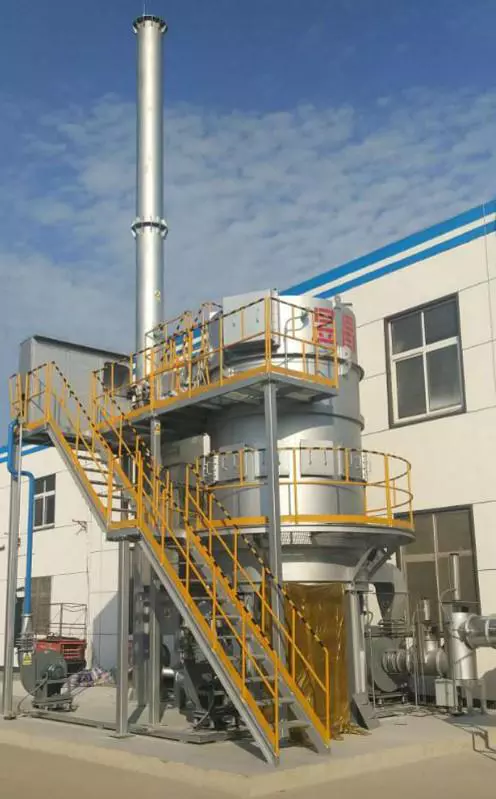RTO Thermal Oxidizer Air Flow
Pendahuluan
Regenerative thermal oxidizers (RTOs) are widely used in various industries for air pollution control. RTOs work by heating contaminated air to high temperatures, which breaks down pollutants into harmless gases. The air flow within an RTO is a critical factor that directly affects its performance, efficiency, and operating costs. In this blog post, we will explore the different aspects of RTO air flow and its importance in achieving optimal RTO performance.
The Basics of RTO Air Flow
RTO air flow is the volume of air that enters and exits an RTO during its operation. The air flow is measured in cubic feet per minute (CFM) or cubic meters per hour (m3/h). The air flow rate is determined by the size and design of the RTO and the amount of contaminated air that needs to be treated.
Controlling RTO Air Flow
The air flow rate in an RTO is controlled by several factors, including the size of the inlet and outlet ducts, the size of the combustion chamber, and the size and number of the heat exchangers. RTOs are designed to handle a specific air flow rate range, and exceeding this range can cause problems such as reduced efficiency, increased energy consumption, and decreased equipment lifespan.
Measuring RTO Air Flow
Measuring RTO air flow is essential to maintaining optimal system performance. Common methods used to measure air flow in an RTO include differential pressure sensors, thermal anemometers, and vortex shedding flow meters.
The Importance of Proper RTO Air Flow
Proper RTO air flow is critical to achieving optimal performance and efficiency. Insufficient air flow can result in incomplete combustion, which leads to the emission of harmful pollutants. Excessive air flow can cause higher energy consumption and increased operating costs.
Efisiensi Energi
Optimizing RTO air flow is crucial for improving energy efficiency. By controlling air flow, RTOs can reduce energy consumption and save on operating costs. Improper air flow can also cause temperature imbalances within the system, further reducing energy efficiency.
Reducing Emissions
Proper air flow also plays a crucial role in reducing emissions. Insufficient air flow can cause incomplete combustion, leading to the emission of pollutants such as volatile organic compounds (VOCs) and hazardous air pollutants (HAPs). With proper air flow control, RTOs can achieve maximum destruction efficiency and reduce harmful emissions.
RTO Air Flow Control Strategies
Several strategies can be used to control RTO air flow and optimize system performance.
Heat Recovery
Heat recovery is a strategy that uses heat exchangers to recover heat from the exhaust air before it leaves the system. This recovered heat is then used to preheat the incoming air, reducing the amount of energy needed to heat the air to the required temperature.
Variable Frequency Drives (VFDs)
VFDs are another strategy used to control RTO air flow. VFDs allow for precise control of the fan speed, which can be adjusted to match the required air flow rate. This results in reduced energy consumption and improved system performance.
Combustion Control
Controlling the combustion process is another strategy used to optimize RTO air flow. By controlling the fuel and air supply to the combustion chamber, the air flow rate can be adjusted to achieve optimal combustion efficiency.
Kesimpulan
In conclusion, RTO air flow is a critical factor in achieving optimal system performance and efficiency. Proper air flow control can reduce energy consumption, lower operating costs, and reduce harmful emissions. By implementing strategies such as heat recovery, VFDs, and combustion control, RTOs can achieve maximum performance and reduce their environmental impact.
Pengenalan Perusahaan
We are a high-tech equipment manufacturing company specializing in the comprehensive treatment of volatile organic compound (VOC) exhaust gases and carbon reduction and energy-saving technologies. Our core technologies include thermal energy, combustion, sealing, and self-control. We have the capabilities for temperature field simulation, air flow simulation modeling, ceramic heat storage material performance, molecular sieve adsorbent material selection, and VOC high-temperature incineration oxidation testing.
Team Advantages
We have an RTO technology research and development center and an exhaust gas carbon reduction engineering technology center in Xi’an, as well as a 30,000 square meter production base in Yangling. We are a leading manufacturer of RTO equipment and molecular sieve rotating wheel equipment globally. Our core technical team comes from the Aerospace Liquid Rocket Engine Research Institute (Aerospace Sixth Institute). With more than 360 employees, including over 60 R&D technology experts, we have 3 senior engineers, 6 senior engineers, and 210 thermodynamics PhDs.
Produk Inti
Our core products include the regenerative thermal oxidizer (RTO) with rotary valve heat storage and the molecular sieve adsorption concentration rotating wheel. Combined with our expertise in environmental protection and thermal energy system engineering, we provide customers with comprehensive solutions for industrial waste gas treatment, energy utilization, and carbon reduction under various operating conditions.
Sertifikasi, Paten, dan Penghargaan
- Sertifikasi Sistem Manajemen Kekayaan Intelektual
- Sertifikasi Sistem Manajemen Mutu
- Sertifikasi Sistem Manajemen Lingkungan
- Construction Industry Qualification
- High-Tech Enterprise
- Patents for Rotary Valve Heat Storage Oxidation Furnace
- Patents for Rotor Type Heat Storage Incineration Equipment
- Patents for Disc Molecular Sieve Rotating Wheel, etc.

Choosing the Right RTO Equipment
- Determine the exhaust gas characteristics
- Memahami peraturan setempat dan standar emisi
- Mengevaluasi efisiensi energi
- Pertimbangkan operasi dan pemeliharaan
- Analisis anggaran dan biaya
- Pilih jenis RTO yang sesuai
- Pertimbangkan faktor lingkungan dan keselamatan
- Performance testing and validation

Service Process
- Consultation and assessment:
- Preliminary consultation
- On-site inspection
- Needs analysis
- Design and solution development:
- Design proposal
- Simulation and modeling
- Solution review
- Production and manufacturing:
- Customized production
- Quality control
- Factory testing
- Installation and commissioning:
- On-site installation
- Commissioning and operation
- Training services
- After-sales support:
- Regular maintenance
- Technical support
- Spare parts supply
We are a one-stop solution provider with a professional team dedicated to customizing RTO solutions for our clients.
Penulis: Miya
